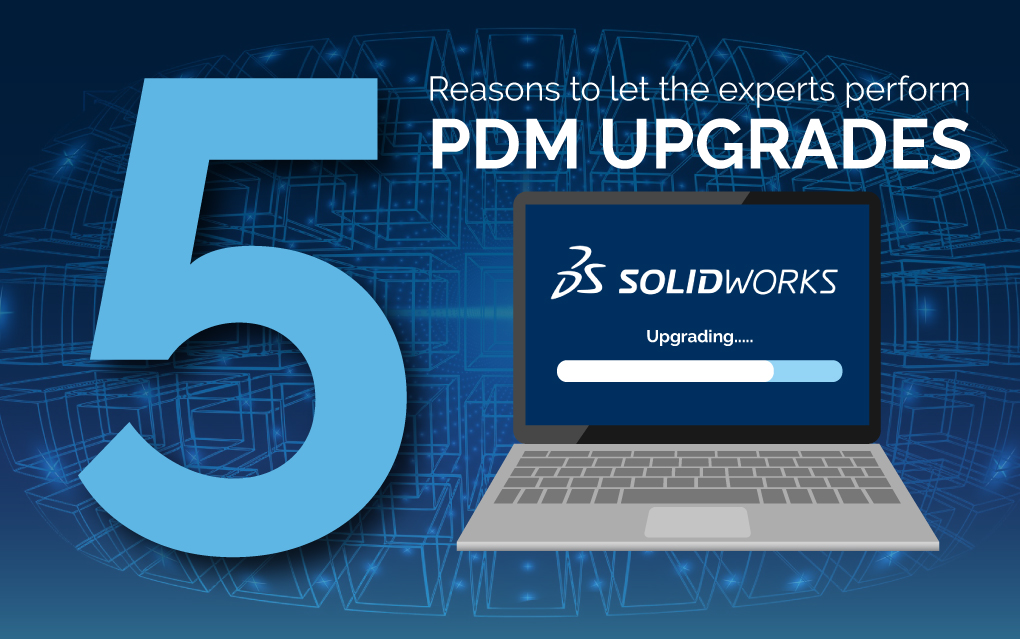
Upgrading SOLIDWORKS PDM, at least annually, should not be considered optional. Nevertheless, a few reasons compel people to defer the undertaking to the future. One reason is saving money, which is a myth. Since 2016, renewing lapsed subscriptions includes the cost of all “skipped” major releases of the software. The overall cost is the same as upgrading annually but comes due all at once in the Nth year.
Another reason is that you may feel it’s not worth the effort because you don’t “need” the new features rolled out with the release. However, admins and users will benefit from the improvements to performance and reliability that are rolled out with them (and probably the new features, too).
If not for those reasons, the time and complexity involved in the upgrade are usually blamed for putting it off. Veteran PDM administrators are familiar with arduous off-hours upgrades, accompanied by the angst of fearing a misstep that can push downtime into valuable production hours.
We grade ourselves on our customers’ success, so we absolutely want you to be running the latest and greatest version of SOLIDWORKS PDM at all times. We also want those upgrades to go smoothly. So, if you are considering postponing your upgrade for any of the above reasons or are leery of performing the red-eye work, please lean on us to take on the task instead. For every reason not to upgrade or to go it alone with doubts or reservations, there are several better reasons to have us lead the effort.
Here are five key reasons:
1. Expertise in PDM Upgrades
If you’re like me, doing something once per year is like starting afresh each time, regardless of what rep you’re on. For those of you with many reps and a better memory than mine, we still caution against the false assumption that every upgrade is identical.
The SOLIDWORKS PDM installation guide spans approximately 180 pages and receives updates with each new release. The specific pages relevant to your PDM upgrade can vary significantly, depending on your unique PDM environment and the changes introduced in the latest release.
Our team of experts specializes in this process, conducting upgrades regularly, which keeps us well-versed in the current procedures. You can expect more speed and accuracy from a GSC-led upgrade than from DIY efforts, and admins can concentrate on what they do best knowing that we will iron out any wrinkles before your users return to their desks.
2. Best Practices
The SOLIDWORKS PDM Installation Guide is fairly unambiguous, but there are multiple ways to navigate the process. It’s not exactly written in a choose-your-own-adventure format, but some variables are involved like:
- Which parts are optional in your environment?
- Which housekeeping measures should take place before getting started?
- What’s the preferred order of operations?
Because of our familiarity with all the facets, nuance, and minutia in play, you can rest assured that GSC will follow best practices at each juncture of the upgrade process and that any potential troubleshooting can start with ruling out any misinterpretations of the standard operating procedure.
3. Streamlined Troubleshooting
The best way to ensure troubleshooting won’t be a part of your upgrade is to let GSC’s technical team do the work. As unlikely as it is, with the multitude of moving parts, there is a nonzero chance a hiccup may temporarily halt the upgrade progress. Just about all potential hiccups are easily recognized and rectified by our experts. Still, in the rare event an anomaly isn’t easily triaged, we have a direct line to SOLIDWORKS for additional support.
4. Efficiency is Key
There is a nexus between doing things right and doing things quickly, a balance we’ll refer to as efficiency. Ensuring no essential backend data is left behind in the upgrade process is critical to the success of the end state, but that doesn’t mean that it needs to take forever.
We possess a wealth of pro tips to expedite the process, but unfortunately, these insights often come into play when it’s too late to apply them. This is especially important when upgrading large datasets and/or simultaneously upgrading multiple vaults at once. In such situations, time is of the essence, and no one wants to be held responsible for extended downtime.
5. Addressing Prerequisites
Upgrades happen as a response to technological evolution, and SOLIDWORKS PDM relies on ancillary systems that are evolving alongside it. Each upgrade is, in part, required to support that evolution. Machine hardware, server hardware, operating systems, database software, VPN connections, etc., are all variables in this equation. To solve this equation, each new software release may require some reconfiguration. This is the most technical component of the upgrade, and the PDM Admin/IT overlap at many organizations is not conducive to solving this equation on its own. GSC’s team of experts has the PDM administration and IT skillsets to work both sides of the equation and broker communication to all parties involved.
Download GSC’s Hardware Recommendations for SOLIDWORKS
Upgrade Your SOLIDWORKS
In the end, there is no “good” reason to skip the upgrade when a new release becomes available. GSC is here to support you annually when the new release arrives. Stay ahead of the curve and partner with us for a seamless PDM upgrade experience.
Learn more about the benefits of upgrading here.
Share
Meet the Author

